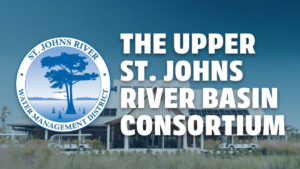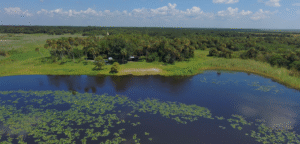How Wetlands and Floodplain Preservation Support Flood Protection—And Why It Matters as Hurricane Season Begins
The St. Johns River Water Management District is dedicated to protecting and managing vital floodplains and conservation areas throughout our 18-county region. By preserving these natural landscapes, the District helps reduce flood risks, improve water quality and enhance ecosystem resilience year-round.
Hurricane season officially begins June 1, making this the perfect time to review how natural systems like wetlands and floodplains protect our communities—and how you can prepare for severe weather.
- Natural Water Storage
Wetlands and floodplains act as natural reservoirs, absorbing and holding excess rainwater and runoff during storms. This reduces the speed and volume of water flowing downstream, which helps prevent sudden flooding and lowers flood peaks—especially important during hurricanes, when rainfall can be intense and prolonged.
- Slowing and Spreading Floodwaters
Vegetation in these areas slows down moving water and helps distribute it more evenly across the landscape. This “braking” effect reduces the force and height of floodwaters, minimizing erosion and property damage during tropical storms and hurricanes.
- Protecting Downstream Communities
By holding and gradually releasing water, wetlands and floodplains help protect homes, businesses and infrastructure downstream from severe flood impacts.
- Reducing Storm Surge and Coastal Flooding
Coastal wetlands and marshes serve as buffers against storm surge, absorbing wave energy and reducing the impact of hurricanes and tropical storms on inland areas.
- Cost-Effective Flood Management
Preserving and restoring wetlands and floodplains often provides flood protection benefits similar to engineered solutions, such as levees or retention ponds, but at a lower cost and with added environmental advantages.
- Additional Environmental Benefits
Beyond flood protection, these areas improve water quality by filtering pollutants and provide important habitat for fish and wildlife, supporting overall ecosystem health and resilience.
Wetlands and floodplain preservation are essential, nature-based strategies for reducing flood risks and protecting communities—especially as we enter another hurricane season.
Ways You Can Prepare Now for Hurricane Season
- Review Your Insurance
- Flood insurance: Check your policy or consider purchasing flood insurance if you don’t have it. Remember, new policies typically take 30 days to become effective, so don’t delay.
- Build Your Hurricane Kit
- Stock up early: Gather non-perishable food, water and medications for at least 3–7 days for your family and pets.
- Essentials: Include portable chargers, a battery-powered radio, flashlights and extra batteries.
- Checklists: Find a printable disaster supply checklist at floridadisaster.org.
- Prepare Your Home
- Yard and trees: Trim back trees and shrubs.
- Gutters and drainage: Clean gutters and ensure downspouts direct water at least four feet from your home’s foundation.
- Home retrofitting: Learn more about strengthening your home at Planning for Your Home.
- Prepare Your Vehicle
- Fuel up: Keep your gas tank at least half full throughout hurricane season to avoid last-minute lines.
- Make a Family Plan
- Communication: Decide where you’ll meet if separated and include pets in your plan.
- Contacts: Share your plan with family and friends.
- Know Your Evacuation Zone
- Evacuation doesn’t always mean far: Sometimes, just a few miles to a safer area is enough.
- Find your zone: Check evacuation zones at floridadisaster.org/knowyourzone.
- Shelters: Identify nearby shelters and alternative locations outside evacuation zones.
Stay Informed All Season Long
- Monitor alerts: Sign up for local emergency notifications and follow trusted sources for weather updates.
- Visit our website: For the latest resources and updates, go to www.sjrwmd.com/storm.





